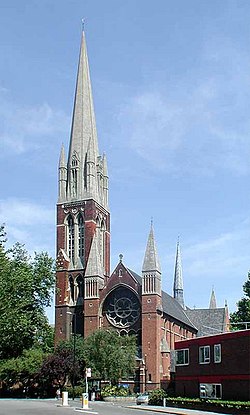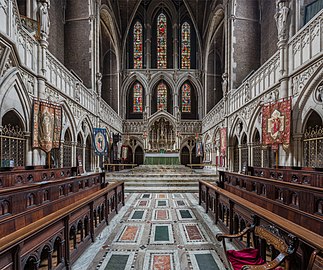
In Eastern Christianity, an iconostasis is a wall of icons and religious paintings, separating the nave from the sanctuary in a church. Iconostasis also refers to a portable icon stand that can be placed anywhere within a church. The iconostasis evolved from the Byzantine templon, a process complete by the 15th century.
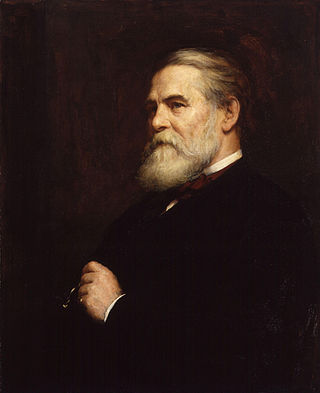
John Loughborough Pearson was a British Gothic Revival architect renowned for his work on churches and cathedrals. Pearson revived and practised largely the art of vaulting, and acquired in it a proficiency unrivalled in his generation. He worked on at least 210 ecclesiastical buildings in England alone in a career spanning 54 years.
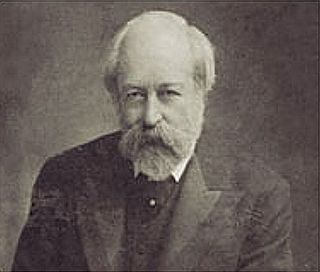
George Frederick Bodley was an English Gothic Revival architect. He was a pupil of Sir George Gilbert Scott, and worked in partnership with Thomas Garner for much of his career. He was one of the founders of Watts & Co.
The Cathedral of the Good Shepherd is the oldest Roman Catholic church in Singapore, built in 1847. It is located in the Museum Planning Area within the Civic District.
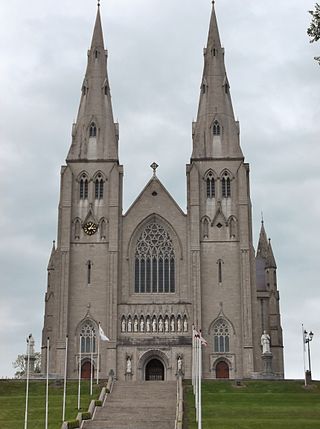
St. Patrick's Cathedral in Armagh, Northern Ireland is the seat of the Catholic Archbishop of Armagh, Primate of All Ireland. It was built in various phases between 1840 and 1904 to serve as the Roman Catholic Cathedral of the Archdiocese of Armagh, the original Medieval Cathedral of St. Patrick having been appropriated by the state church called the Church of Ireland at the time of the Irish Reformation.

Rouen Cathedral is a Catholic church in Rouen, Normandy, France. It is the see of the Archbishop of Rouen, Primate of Normandy. It is famous for its three towers, each in a different style. The cathedral, built and rebuilt over a period of more than eight hundred years, has features from Early Gothic to late Flamboyant and Renaissance architecture. It also has a place in art history as the subject of a series of impressionist paintings by Claude Monet.

Saint-Étienne-du-Mont is a church in Paris, France, on the Montagne Sainte-Geneviève in the 5th arrondissement, near the Panthéon. It contains the shrine of St. Geneviève, the patron saint of Paris. The church also contains the tombs of Blaise Pascal and Jean Racine. Jean-Paul Marat is buried in the church's cemetery.

The Cathedral Basilica of Saint Francis of Assisi, commonly known as Saint Francis Cathedral, is a Roman Catholic cathedral in downtown Santa Fe, New Mexico. It is the mother church of the Archdiocese of Santa Fe.
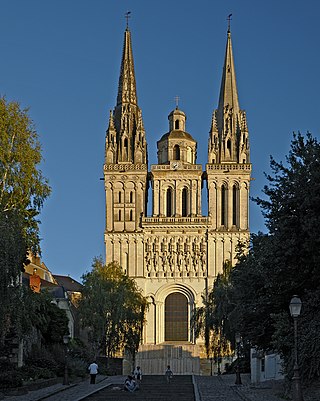
Angers Cathedral is a Roman Catholic church dedicated to Saint Maurice in Angers, France. It is the seat of the Bishops of Angers.

Rodez Cathedral is a Roman Catholic church located in town of Rodez, in the department of Aveyron in the Occitanie region of Southern France. The cathedral is a national monument and is the seat of the Bishopric of Rodez. The west front, of a military appearance and without a portal, formerly was part of the city wall of Rodez. Notable elements include a Flamboyant Gothic and Renaissance tower, and a Renaissance rood screen and choir stalls.

St. Peter's Cathedral, Charlottetown, Prince Edward Island, Canada, was founded in 1869 as a result of the influence of the Oxford Movement. Since that time, the parish has remained Anglo-Catholic in ethos and practice.

St John the Divine, Kennington, is an Anglican church in London. The parish of Kennington is within the Anglican Diocese of Southwark. The church was designed by the architect George Edmund Street in the Decorated Gothic style, and was built between 1871 and 1874. Today it is a grade I listed building.

St George's Cathedral is the Anglican cathedral in Cape Town, South Africa, and the seat of the Archbishop of Cape Town. St. George's Cathedral is both the metropolitical church of the Anglican Church of Southern Africa and a congregation in the Diocese of Cape Town.

Stephen Ernest Dykes Bower was a British church architect and Gothic Revival designer best known for his work at Westminster Abbey, Bury St Edmunds Cathedral and the Chapel at Lancing College. As an architect he was a devoted and determined champion of the Gothic Revival style through its most unpopular years. He rejected modernism and continued traditions from the late Victorian period, emphasising fine detail, craftsmanship and bright colour.

St Saviour's is an Anglo-Catholic church in Pimlico, City of Westminster, London, England, located at the north end of St George's Square. It was constructed in the 1860s as part of Thomas Cubitt's development of the area on behalf of the Marquess of Westminster. The church was designed by Thomas Cundy, who had previously built St Gabriel's Pimlico a short distance away. As with St Gabriel's, St Saviour's was designed in the Gothic style and built in ragstone to emphasise the contrast with the classical stucco of its secular neighbours. The church is Grade II listed.
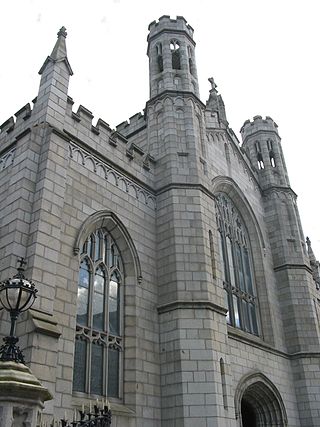
The Cathedral of Saint Patrick and Saint Colman or Newry Cathedral is a Roman Catholic cathedral located in Newry, Northern Ireland. It acts as the seat of the Bishop of Dromore, and the Mother church of the Roman Catholic Diocese of Dromore. Prior to the COVID-19 pandemic, over 200,000 people visited the cathedral each year.

The Church of the Immaculate Conception on the motherhouse grounds of the Sisters of Providence of Saint Mary-of-the-Woods is a large Italian Renaissance Revival-style church constructed of Indiana limestone at Saint Mary-of-the-Woods, Indiana. The cathedral-like structure, which is the fourth church/chapel of the Sisters of Providence since their arrival at Saint Mary-of-the-Woods in 1840. Construction for the church began in 1886; its exterior was completed in 1891 and the interior was completed in 1907. The church was consecrated on October 23, 1907, and continues to serve as a place of daily worship services that are open to the public. The church also houses the shrine and tomb of Saint Mother Théodore Guérin, foundress of the Sisters of Providence of Saint Mary-of-the-Woods. Our Lady of Sorrows Chapel (1905) was erected in the crypt beneath the church.

St. John's Church, or St. John's Episcopal Church, founded in 1786, is an historic Episcopal church located at 101 South Prospect Street in the South Prospect Street Historic District of Hagerstown, Maryland. It is the seat of Saint John's Parish, Diocese of Maryland, which covers most of Washington County, Maryland.

Trinity Episcopal Cathedral is an Episcopal cathedral located in Trenton, New Jersey, United States. It is the seat of the Diocese of New Jersey.

The Church of St Teresa of Avila in Everton Road, Birkdale, Southport, Sefton, Merseyside, England, is an active Roman Catholic church in the diocese of Liverpool. It was built in 1897–98 and designed by the architectural partnership of James Sinnott, Bernard Sinnott & Daniel Powell. The church, together with its attached presbytery, is recorded in the National Heritage List for England as a designated Grade II listed building.
